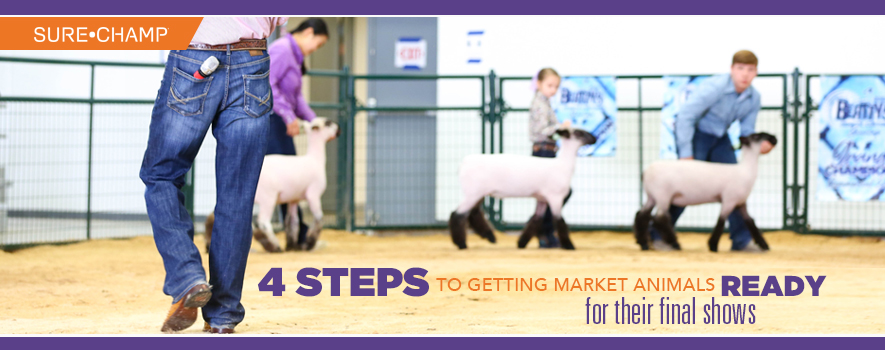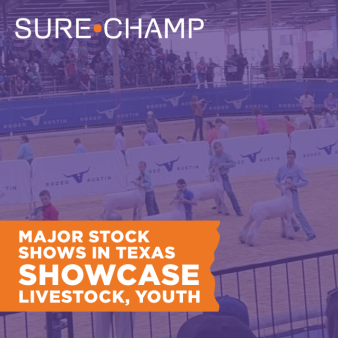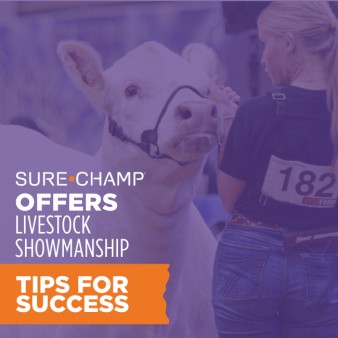
You don’t get a second chance to make a first impression. This rings true if you are in a job interview, on a first date or leading or driving your favorite animal into the ring. Sure, you and your family have had the opportunity to spend hours, even days studying structure, muscle, condition, hair and skin on your animal. However, at this animal’s final show, the judge is going to take moments, maybe less than a minute to determine if he or she will pull you into line or pen you for one more look.
Getting a market animal ready for their target show, whether that is a state fair, junior expo or other endpoint doesn’t happen overnight, the last two weeks or even in 30 days. It is a science and an art that takes effort in nutrition, exercise, health care and appearance that should start as soon as you get your animal brought into your barn.
Feeding Regimen
Blaine Rodgers, Western U.S. Area Sales Manager & Show Livestock Manager for BioZyme® Inc., said that the most important thing for livestock exhibitors and feeders to understand is their timeline from start to finish of their project. They should know their final show dates, calculate the number of days the animals will be on feed and ultimately feed so the animal won’t need to be pushed to hard or held too much toward the end of the project, which can have a negative impact on structure and muscle shape and composition.
“Having a good game plan and strategy and being prepared and having your animal in the right spot is really important so you can coast along and don’t have to feed them excessively or put a lot of weight gain on them at the last minute, things that effect soundness and structure, two of the most important things to an animal. People try to push animals way too hard for what their skeleton is capable of,” Rodgers said.
Once you know your days on feed until your final show, calculate your projected average daily gain and what it will take to get your animal to its desired endpoint. If you are newer to feeding an animal, visit with the breeder of your animal, a livestock nutritionist, a 4-H leader or FFA advisor in your area for advice. Also, be sure you know your final show’s weight minimums and maximums.
Finally, Rodgers stressed that free-choice water is vital to the overall well-being of the animal. Make sure your animal, regardless of species has plentiful fresh, clean, cold water, especially in the summer. Water intake directly correlates to appetite.
Supplement Savvy
Although feeding doesn’t always work out as planned, and animals do sometimes go off feed or are more efficient in their gain, there are ways to supplement your livestock to help achieve their goals as they reach the last few weeks. If an animal appears too over conditioned and needs to be hardened up or leaned up, you can feed it protein. Likewise, if the animal is too thin or needs some mass, try one of several fat supplements to help it appear more market ready.
Supplements not only help your animals grow, but they also fulfill other needs. If you do have an animal that you are pushing to gain and you are worried about its structural integrity or if you simply have an animal that might have some issues with its movement, Rodgers suggests Sure Champ® Joint Juice. This product lubricates joints and naturally restores synovial fluid to alleviate joint discomfort. Sure Champ Joint Juice contains MHB3® Hyaluronan, the most highly researched and proven hyaluronic acid available. It is carefully crafted to naturally support, promote and enhance joint and soft tissue health.
Joint Juice is not a “quick fix” according to Rodgers, but it is meant to be more of a preventative product, working to keep joints sound, as the skeleton grows and develops muscle mass. Ideally, cattle should be on Joint Juice for 90-100 days, and smaller animals like sheep, goats and hogs should use Joint Juice for 60 days in order to receive the full benefits.
Keeping your animals healthy should be a priority and overall health starts with their digestive health. Sure Champ and Vita Charge® also offer supplements to help keep their digestive system in check, and keep your livestock eating and drinking through the summer heat and other stress that showing and hauling involve. Products like Sure Champ Extreme, Sure Champ Cattle and Vita Charge Liquid Boost offer the Amaferm® advantage to promote appetite and digestive health. Each product also offers other benefits to help your show livestock excel in the ring.
Exercise Importance
Exercise is vital to building lean muscle mass, especially in small ruminants like sheep and goats. However, it benefits all species at various levels. Remember when it is the summertime and high heat and humidity exist in the peak of the day, you will want to exercise your animals in the early morning or later in the evening when the temperatures cool off to help keep your animals comfortable and to avoid unnecessary heat stress.
In addition to building muscle shape in livestock, Rodgers reminds that exercise offers some other secondary benefits as well. In cattle, it helps to keep their structure loose and helps to build their appetite, especially when they are typically kept tied inside a small, climate-controlled area most of their day in an effort to grow hair.
For pigs, exercise is important to help build their lung capacity and endurance when they might be asked to drive in a hot show ring for 15 to 20 minutes at a time. Not every state fair show ring is air conditioned, so train your pigs to walk outside in the heat and gradually work them up to walking 20 to 30 minutes at a time so they don’t pant or show signs of being tired. Products like the Vita Charge Climate Control Gel or Sure Champ Extreme will help any species help maintain their normal body temperatures.
Make ‘em Shine
Remember that first impression you want to make? That all comes down to what the judge will see when you enter the ring, and that is the outward appearance of your animal.
“When you hit the ring, you want your animal to be presented like a champion,” Rodgers said.
That first impression will likely come from a combination of skin and hair and how they are presented – showmanship. Therefore, you will want to focus on these areas daily.
“As competitive as the junior livestock arena has become, it is a game of inches,” Rodgers said.
Taking care of your animals’ appearances comes down to daily washing or rinsing, conditioning and brushing. There are many protocols out there, and you should follow the one best suited for you and your animals.
Practicing showmanship can often be done while exercising or after exercising, and it is important so your animal is comfortable with you – the exhibitor – and the two of you can make that great first impression. With cattle, sheep and goats it is often the duo that is set up correctly first that makes the best first impression. When driving a pig, you want to make the judge say “wow” with an easy striding hog that has its head up.
You only get a small amount of time to make an initial impression. Keeping structure and soundness in mind with a feeding regimen and the proper use of supplements is paramount. Round that off with a good exercise program and daily hair and skin work while practicing showmanship skills. Your first impression at your animal’s last show will help you find your way to the backdrop.

